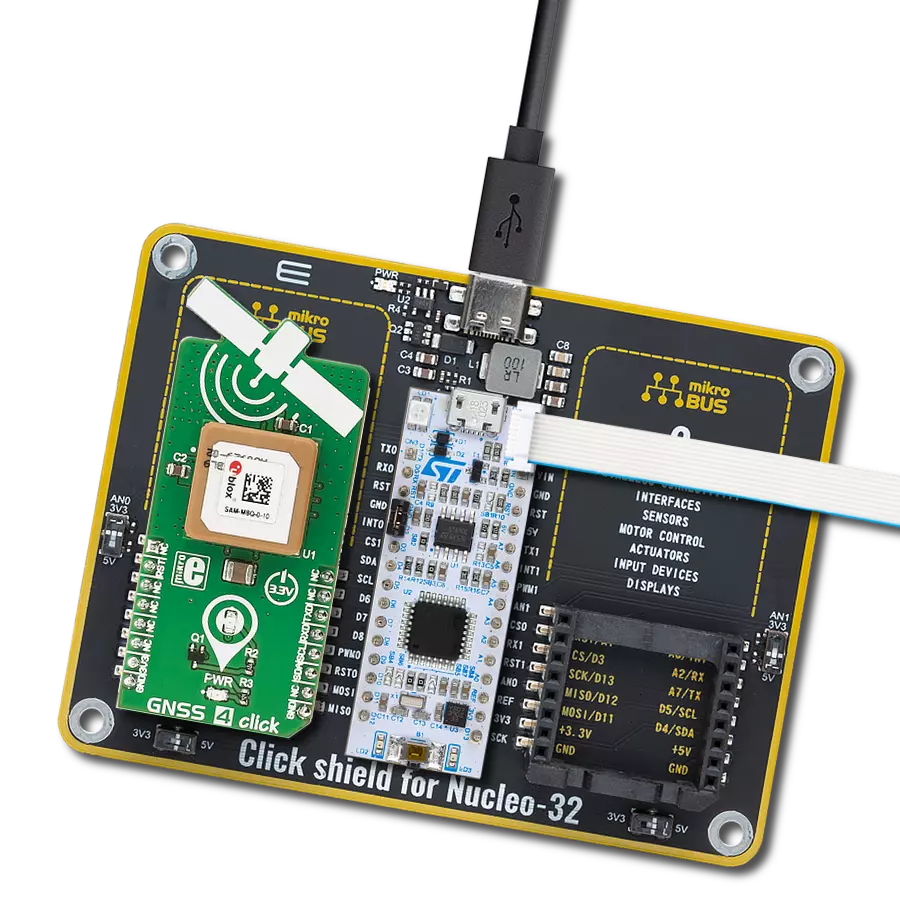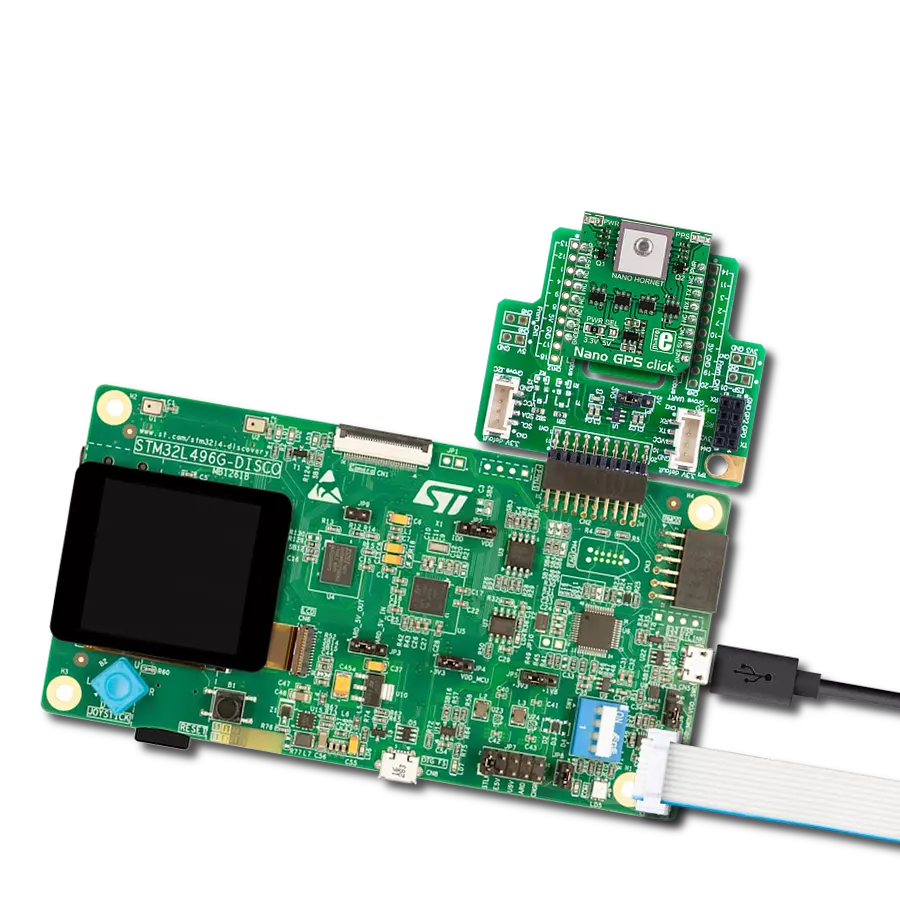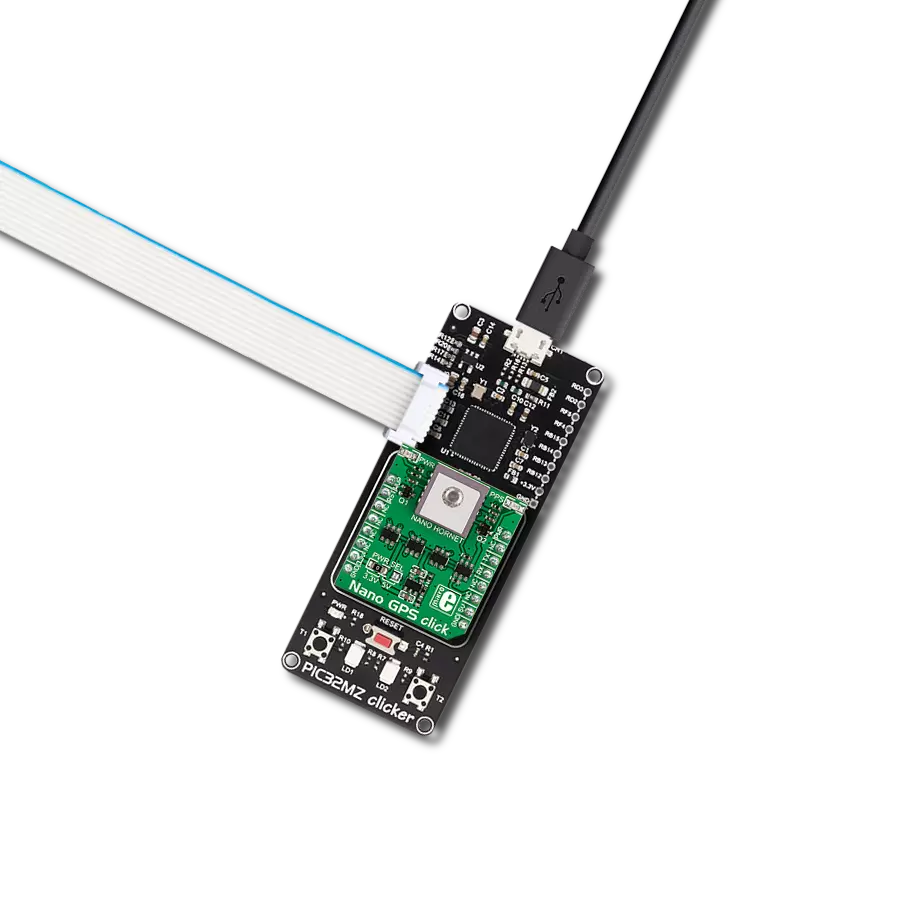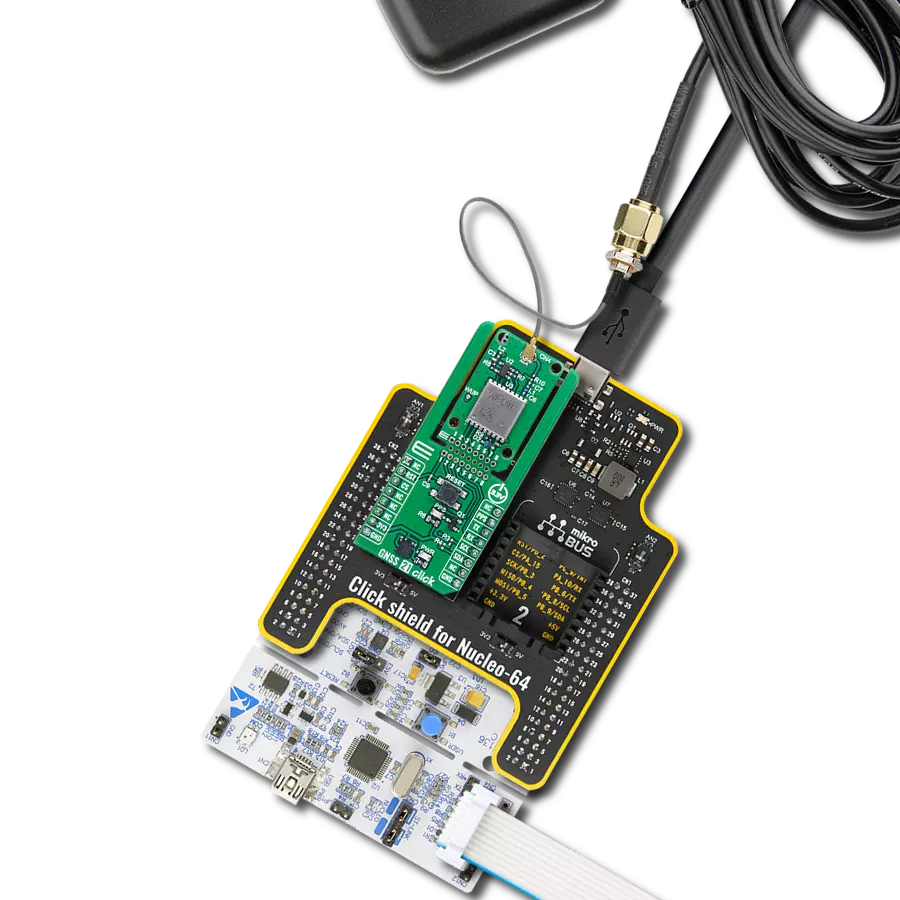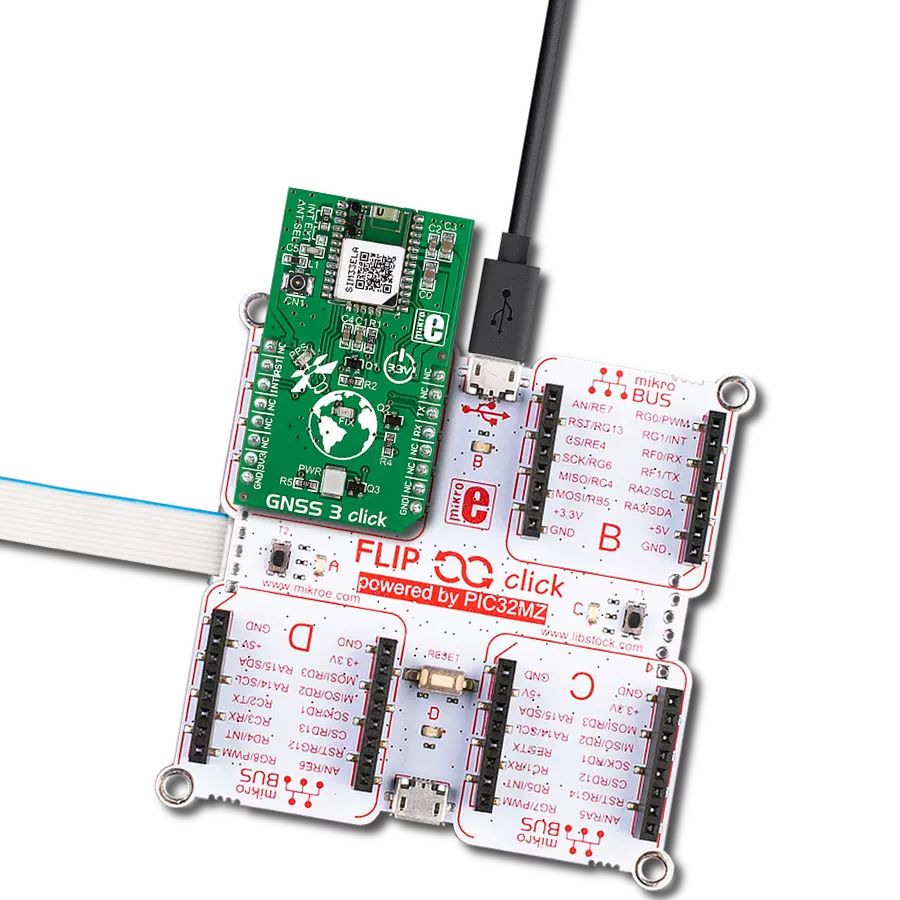Track GPS, GLONASS, Galileo, BeiDou, QZSS satellites simultaneously for enhanced position accuracy, especially in urban environments
A
A
Hardware Overview
How does it work?
GNSS 17 Click is based on the M20071, an integrated full-function GNSS receiver module from Antenova. This module includes the MediaTek AG3335MN flash chip, enabling concurrently tracking multiple GNSS constellations, such as GPS, GLONASS, GALILEO, BEIDOU, and QZSS. The M20071's advanced multi-path algorithms enhance position accuracy, especially in dense urban environments. Additionally, the onboard LNA ensures excellent performance in weak-signal scenarios, making it ideal for wearable devices. This Click board™ is perfect for various applications, including portable devices, asset tracking, personal safety, sports electronics, and navigation systems, providing reliable and precise location services. The M20071 also carries several significant features that enhance this board's functionality. The EPO (Extended Prediction Orbit) fast fix capability allows the module to use up to 30-day orbit predictions, enabling an instant fix solution. The EASY (Self-Generated Orbit Prediction) feature also accelerates the TTFF (time-to-first-fix) performance by providing up to 3 days of GPS orbit predictions without needing an internet connection or software on a host processor. Furthermore, the AIC (Active Interference Cancellation) feature offers effective narrow-band interference cancellation, ensuring reliable and accurate GNSS performance even in
challenging environments. The M20071 also offers three power-saving modes: OFF, RTC, and periodic. In OFF mode, controlled via the EN pin of the mikroBUS™ socket, the module only keeps the power management logic active, with all other logic powered down when the EN pin is in a LOW logic state. RTC mode, a low-power state managed through the RTC pin of the mikroBUS™ socket, shuts down the system core. The module cannot send commands or provide position-related information in this mode, but it saves navigation data to RTC-RAM. Upon waking, the module uses this saved data to regain a position fix quickly. The periodic mode is a user-configurable state where the module alternates between running and sleeping, reducing current consumption while maintaining updated data. This flexibility allows users to tailor the module's operation according to specific power and performance needs. The M20071 module and the host MCU are communicated through a UART interface using the standard UART RX and TX pins. The default communication speed is set at 115200bps, ensuring efficient data exchange. In addition to the UART TX and RX pins, the board uses an RTS pin for handshaking with the host MCU to prevent missed commands. Furthermore, GNSS 17 Click includes a green PPS LED indicator, which emits a synchronized pulse signal from the M20071 once
per second. This pulse signal has a default width of 100 ms but can be configured between 50 ms and 999 ms. The PPS function is enabled by default, and the module will output the PPS signal once a 3D fix is achieved. The M20071 does not require a specific power-up sequence, but it does need a voltage of 1.8V for its system core to function correctly. To achieve this, two small AP2112 LDO regulators provide the necessary 1.8V voltage from the mikroBUS™ power rails, supplying power to both the M20071 and its GNSS antenna supply. Besides mikroBUS™ power rails, this board also supports a backup supply from an attached coin battery at the back of the board. The regulator responsible for the GNSS antenna supply can be activated via the AON pin of the mikroBUS™ socket. This Click board™ can operate with both 3.3V and 5V logic voltage levels selected via the VCC SEL jumper. Given that the M20071 module operates at 1.8V, a logic-level translator, the TXB0106, is also used for proper operation and an accurate signal-level translation. This way, both 3.3V and 5V capable MCUs can use the communication lines properly. Also, this Click board™ comes equipped with a library containing easy-to-use functions and an example code that can be used as a reference for further development.
Features overview
Development board
EasyPIC PRO v8 is a development board specially designed for the needs of rapid development of embedded applications. It supports many high pin count 8-bit PIC microcontrollers from Microchip, regardless of their number of pins, and a broad set of unique functions, such as the first-ever embedded debugger/programmer over WiFi. The development board is well organized and designed so that the end-user has all the necessary elements, such as switches, buttons, indicators, connectors, and others, in one place. Thanks to innovative manufacturing technology, EasyPIC PRO v8 provides a fluid and immersive working experience, allowing access anywhere and under
any circumstances at any time. Each part of the EasyPIC PRO v8 development board contains the components necessary for the most efficient operation of the same board. In addition to the advanced integrated CODEGRIP programmer/debugger module, which offers many valuable programming/debugging options and seamless integration with the Mikroe software environment, the board also includes a clean and regulated power supply module for the development board. It can use a wide range of external power sources, including a battery, an external 12V power supply, and a power source via the USB Type-C (USB-C) connector.
Communication options such as USB-UART, USB DEVICE, and Ethernet are also included, including the well-established mikroBUS™ standard, a standardized socket for the MCU card (SiBRAIN standard), and two display options (graphical and character-based LCD). EasyPIC PRO v8 is an integral part of the Mikroe ecosystem for rapid development. Natively supported by Mikroe software tools, it covers many aspects of prototyping and development thanks to a considerable number of different Click boards™ (over a thousand boards), the number of which is growing every day.
Microcontroller Overview
MCU Card / MCU
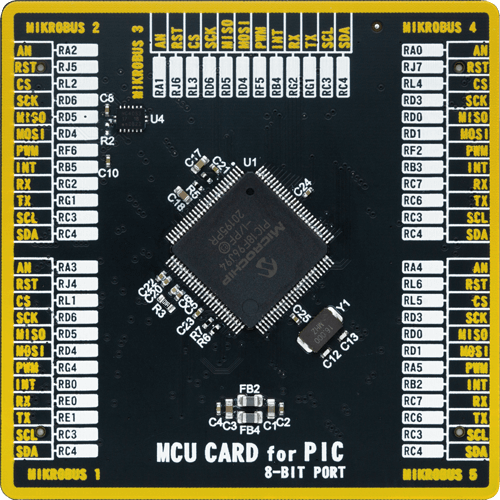
Type
8th Generation
Architecture
PIC
MCU Memory (KB)
64
Silicon Vendor
Microchip
Pin count
100
RAM (Bytes)
3862
You complete me!
Accessories
Active GPS antenna is designed to enhance the performance of your GPS and GNSS Click boards™. This external antenna boasts a robust construction, making it ideal for various weather conditions. With a frequency range of 1575.42MHz and a 50Ohm impedance, it ensures reliable signal reception. The antenna delivers a gain of greater than -4dBic within a wide angular range, securing over 75% coverage. The bandwidth of +/- 5MHz further guarantees precise data acquisition. Featuring a Right-Hand Circular Polarization (RHCP), this antenna offers stable signal reception. Its compact dimensions of 48.53915mm and a 2-meter cable make it easy to install. The magnetic antenna type with an SMA male connector ensures a secure and convenient connection. If you require a dependable external antenna for your locator device, our active GPS antenna is the perfect solution.
Used MCU Pins
mikroBUS™ mapper
Take a closer look
Click board™ Schematic

Step by step
Project assembly
Software Support
Library Description
This library contains API for GNSS 17 Click driver.
Key functions:
gnss17_generic_read- This function reads a desired number of data bytes by using UART serial interface.gnss17_parse_gga- This function parses the GGA data from the read response buffer.gnss17_reset_device- This function resets the device by toggling the EN and AON pins.
Open Source
Code example
The complete application code and a ready-to-use project are available through the NECTO Studio Package Manager for direct installation in the NECTO Studio. The application code can also be found on the MIKROE GitHub account.
/*!
* @file main.c
* @brief GNSS 17 Click Example.
*
* # Description
* This example demonstrates the use of GNSS 17 Click by reading and displaying
* the GNSS coordinates.
*
* The demo application is composed of two sections :
*
* ## Application Init
* Initializes the driver and resets the Click board.
*
* ## Application Task
* Reads the received data, parses the NMEA GGA info from it, and once it receives
* the position fix it will start displaying the coordinates on the USB UART.
*
* ## Additional Function
* - static void gnss17_clear_app_buf ( void )
* - static void gnss17_log_app_buf ( void )
* - static err_t gnss17_process ( gnss17_t *ctx )
* - static void gnss17_parser_application ( uint8_t *rsp )
*
* @author Stefan Filipovic
*
*/
#include "board.h"
#include "log.h"
#include "gnss17.h"
// Application buffer size
#define APP_BUFFER_SIZE 500
#define PROCESS_BUFFER_SIZE 200
static gnss17_t gnss17;
static log_t logger;
static uint8_t app_buf[ APP_BUFFER_SIZE ] = { 0 };
static int32_t app_buf_len = 0;
/**
* @brief GNSS 17 clearing application buffer.
* @details This function clears memory of application buffer and reset its length.
* @note None.
*/
static void gnss17_clear_app_buf ( void );
/**
* @brief GNSS 17 log application buffer.
* @details This function logs data from application buffer to USB UART.
* @note None.
*/
static void gnss17_log_app_buf ( void );
/**
* @brief GNSS 17 data reading function.
* @details This function reads data from device and concatenates data to application buffer.
* @param[in] ctx : Click context object.
* See #gnss17_t object definition for detailed explanation.
* @return @li @c 0 - Read some data.
* @li @c -1 - Nothing is read.
* See #err_t definition for detailed explanation.
* @note None.
*/
static err_t gnss17_process ( gnss17_t *ctx );
/**
* @brief GNSS 17 parser application.
* @param[in] rsp Response buffer.
* @details This function logs GNSS data on the USB UART.
* @return None.
* @note None.
*/
static void gnss17_parser_application ( uint8_t *rsp );
void application_init ( void )
{
log_cfg_t log_cfg; /**< Logger config object. */
gnss17_cfg_t gnss17_cfg; /**< Click config object. */
/**
* Logger initialization.
* Default baud rate: 115200
* Default log level: LOG_LEVEL_DEBUG
* @note If USB_UART_RX and USB_UART_TX
* are defined as HAL_PIN_NC, you will
* need to define them manually for log to work.
* See @b LOG_MAP_USB_UART macro definition for detailed explanation.
*/
LOG_MAP_USB_UART( log_cfg );
log_init( &logger, &log_cfg );
log_info( &logger, " Application Init " );
// Click initialization.
gnss17_cfg_setup( &gnss17_cfg );
GNSS17_MAP_MIKROBUS( gnss17_cfg, MIKROBUS_1 );
if ( UART_ERROR == gnss17_init( &gnss17, &gnss17_cfg ) )
{
log_error( &logger, " Communication init." );
for ( ; ; );
}
log_info( &logger, " Application Task " );
}
void application_task ( void )
{
if ( GNSS17_OK == gnss17_process( &gnss17 ) )
{
if ( app_buf_len > ( sizeof ( GNSS17_RSP_GGA ) + GNSS17_GGA_ELEMENT_SIZE ) )
{
gnss17_parser_application( app_buf );
}
}
}
int main ( void )
{
/* Do not remove this line or clock might not be set correctly. */
#ifdef PREINIT_SUPPORTED
preinit();
#endif
application_init( );
for ( ; ; )
{
application_task( );
}
return 0;
}
static void gnss17_clear_app_buf ( void )
{
memset( app_buf, 0, app_buf_len );
app_buf_len = 0;
}
static void gnss17_log_app_buf ( void )
{
for ( int32_t buf_cnt = 0; buf_cnt < app_buf_len; buf_cnt++ )
{
log_printf( &logger, "%c", app_buf[ buf_cnt ] );
}
}
static err_t gnss17_process ( gnss17_t *ctx )
{
uint8_t rx_buf[ PROCESS_BUFFER_SIZE ] = { 0 };
int32_t overflow_bytes = 0;
int32_t rx_cnt = 0;
int32_t rx_size = gnss17_generic_read( ctx, rx_buf, PROCESS_BUFFER_SIZE );
if ( ( rx_size > 0 ) && ( rx_size <= APP_BUFFER_SIZE ) )
{
if ( ( app_buf_len + rx_size ) > APP_BUFFER_SIZE )
{
overflow_bytes = ( app_buf_len + rx_size ) - APP_BUFFER_SIZE;
app_buf_len = APP_BUFFER_SIZE - rx_size;
memmove ( app_buf, &app_buf[ overflow_bytes ], app_buf_len );
memset ( &app_buf[ app_buf_len ], 0, overflow_bytes );
}
for ( rx_cnt = 0; rx_cnt < rx_size; rx_cnt++ )
{
if ( rx_buf[ rx_cnt ] )
{
app_buf[ app_buf_len++ ] = rx_buf[ rx_cnt ];
}
}
return GNSS17_OK;
}
return GNSS17_ERROR;
}
static void gnss17_parser_application ( uint8_t *rsp )
{
uint8_t element_buf[ 200 ] = { 0 };
if ( GNSS17_OK == gnss17_parse_gga( rsp, GNSS17_GGA_LATITUDE, element_buf ) )
{
static uint8_t wait_for_fix_cnt = 0;
if ( strlen( element_buf ) > 0 )
{
log_printf( &logger, "\r\n Latitude: %.2s degrees, %s minutes \r\n", element_buf, &element_buf[ 2 ] );
memset( element_buf, 0, sizeof( element_buf ) );
gnss17_parse_gga( rsp, GNSS17_GGA_LONGITUDE, element_buf );
log_printf( &logger, " Longitude: %.3s degrees, %s minutes \r\n", element_buf, &element_buf[ 3 ] );
memset( element_buf, 0, sizeof( element_buf ) );
gnss17_parse_gga( rsp, GNSS17_GGA_ALTITUDE, element_buf );
log_printf( &logger, " Altitude: %s m \r\n", element_buf );
wait_for_fix_cnt = 0;
}
else
{
if ( wait_for_fix_cnt % 5 == 0 )
{
log_printf( &logger, " Waiting for the position fix...\r\n\n" );
wait_for_fix_cnt = 0;
}
wait_for_fix_cnt++;
}
gnss17_clear_app_buf( );
}
}
// ------------------------------------------------------------------------ END
Additional Support
Resources
Category:GPS/GNSS






















